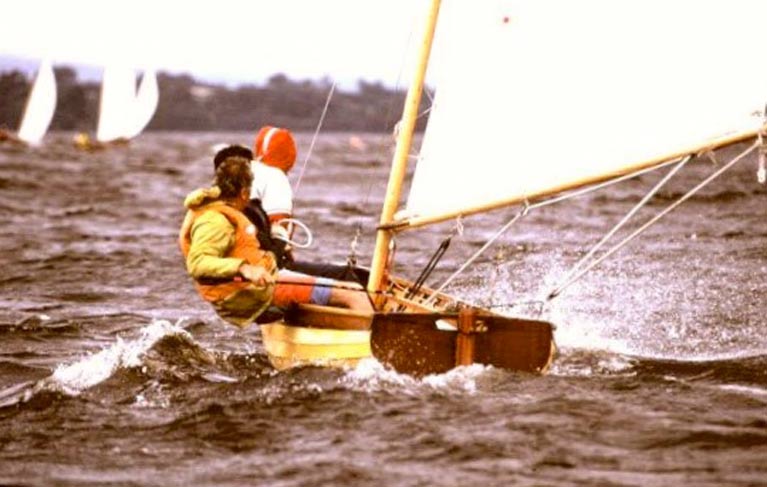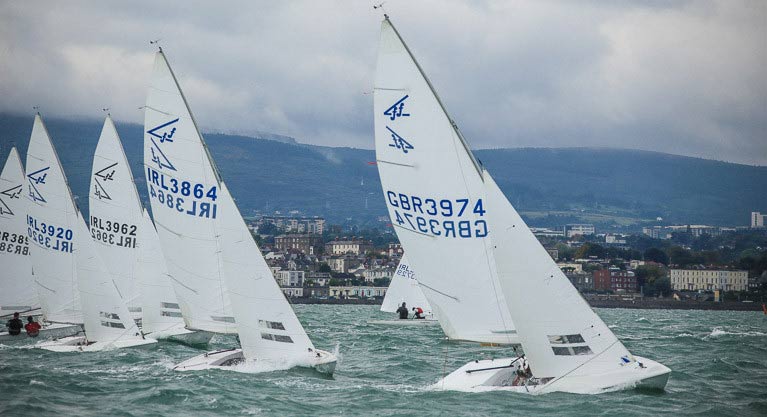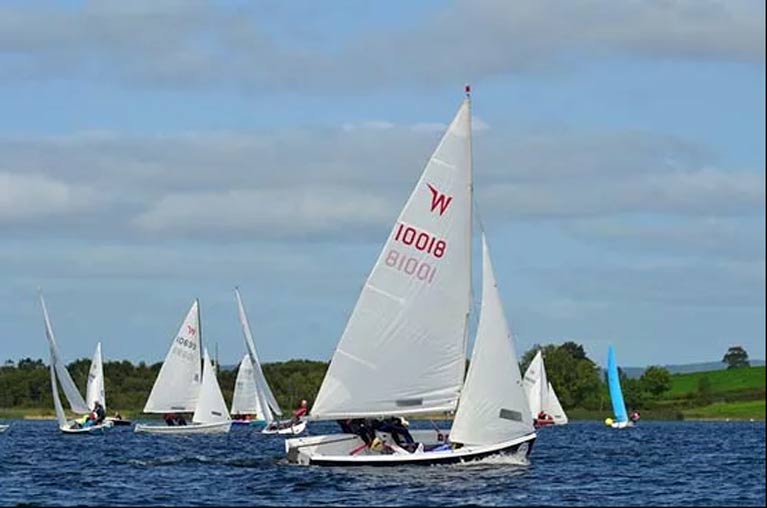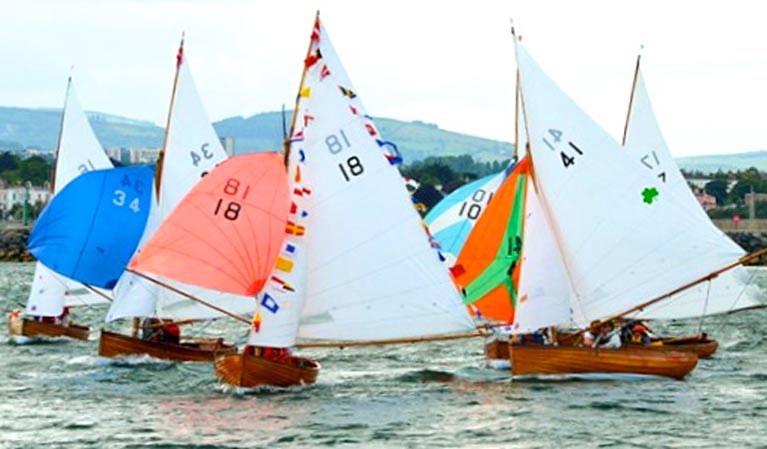They’re the sometimes well-hidden glue that holds key elements of Irish sailing together writes W M Nixon. They’re a formidable power in our sport. They might seem to outsiders like secret societies. Yet each in its own way – for they’re as different in character as the boats and people they represent – do much good work of the best sort. In other words, often in some stealth and behind the scenes.
They are of course, the Class Associations. And because they know that they’re such a power in the world of sailing, the people running the class associations – particularly the more local ones – often like to keep well below the parapet, for what they’re running could well be described as a benevolent Mafia, were such a thing possible
Yet while there are obvious similarities between the many Associations even if their boats are as different as chalk and cheese, it’s the dissimilarities which strike the casual observer, and tonight in the National Yacht Club the annual dinner of the Shannon One Design Association provides a case study which would be of intense interest to sociologists of sailing.
For the Shannon One Designs – which stem from a meeting on January 29th 1920 in Athlone attended by interested sailors from the full sailing length of the Shannon and its lakes – are inevitably a widespread class in their river-length locations. And the owners are an equally various selection of individuals sometimes united only in their love of their exquisite clinker-built 18th classics, boats so beautiful they’ve been described as an occasion of sin, while their construction is so subtle and supple that they take on a twist when going to windward in a breeze – in short, “they turn round and look at you”.
 Shannon One Design going to windward with a bite to the breeze – the slim boats are so supple in construction that the hulls twist in these conditions, such that “they turn round and look at you”
Shannon One Design going to windward with a bite to the breeze – the slim boats are so supple in construction that the hulls twist in these conditions, such that “they turn round and look at you”
Be that as it may, here they all are – the Shannon OD sailors - gathering not in some mysterious Midlands venue which reflects their sailing homes, but instead in an efficient if historic Dun Laoghaire waterfront establishment noted for the quality of its hospitality.
It’s a reflection of the times we live in. While Shannon One Design sailors may re-emerge as completely different characters when they are reunited with their beloved boats at some choice inland sailing venue, in everyday life many of them – probably the majority - live and work in Dublin. And for those who don’t, the Dun Laoghaire package of a hospitable club and a nearby selection of accommodation is an attractive proposition, particularly when winter seems so slow to release its grasp.
But nevertheless there’ll be considerable satisfaction among the born and bred Shannoneers that one of their own, Andrew Mannion of Athlone who sails from Lough Ree YC with No 97, will be collecting the Transom Trophy for best overall performance tonight.
Yet by gathering in the National YC, they’re in the home location of some class associations which are tight-knit units by comparison with the SOD’s own free-form assembly, for in addition to fascinating groups such as the Ruffian 23s which maintain links with sister-classes in Carrickfergus and Hong Kong, the National is the focal point for the impressively-organised Dun Laoghaire Flying Fifteen fleet.
 A tight-knit group. The Dublin Bay Flying Fifteens will be hosting the Subaru Flying Fifteen Worlds from September 6th to 13th.
A tight-knit group. The Dublin Bay Flying Fifteens will be hosting the Subaru Flying Fifteen Worlds from September 6th to 13th.
To describe the Dun Laoghaire F/Fs as “focused” is inadequate. Even the briefest glimpse of their post-race boat retrieval and storage technique is to see a keen class functioning almost as a single organism. And if they’re sending a group to competition, they do it with equal economic efficiency, putting a car transporter to an alternative and very effective use.
So this year when they stage the Subaru Flying Fifteen Worlds from September 6th to 13th, with the Events Committee under the chairmanship of Niall Meagher, and with the supportive oversight of the Flying Fifteen Association of Ireland which is Presided by the NYC’s own star F/F crew Chris Doorly, we’ll be seeing a well-oiled machine in smooth action.
For Flying Fifteens, racing is the be-all and end-all of their existence, but another class which will be holding the equivalent of their Worlds in Ireland this year has an outlook which puts racing in its place as only part of varied sailing year.
The multi-purpose Wayfarer dinghy is just under 16ft long, and seemed ideal for conditions at many Irish sailing centres, yet just half a dozen years ago the Wayfarer was going through very thin times. But now, thanks in no small part to the enthusiasm of Monica Schaefer of Greystones, the Wayfarer has undergone such a renaissance that they’ll be having their International Championship 2019 at Greystones from 22nd to 28th July with a substantial fleet of overseas craft joining the locals, and in addition those who fancy some extra racing beforehand can get it in Volvo Dun Laoghaire Regatta from July 11th to 14th, though others may prefer a spot of cruising, for Wayfarers are a class apart, a class which sees sailing in many different ways.
 Wayfarers in action at Cullaun in County Clare. Their International Championship is at Greystones from 22nd to 28th July.
Wayfarers in action at Cullaun in County Clare. Their International Championship is at Greystones from 22nd to 28th July.
Yet like all other boats, they ultimately owe their health to a vibrant class association run by people who themselves regularly sail, and are approachable to fellow class members. The boats may be different, the associations’ styles may be very different, but underneath all is a comparable level of dedicated enthusiasm.
For instance, you couldn’t think of two boats more different than a Wayfarer and a Dublin Bay Water Wag. One is now the result of modern glassfibre construction, while the other is a clinker-built timber classic. And while there’s a certain non-nonsense attitude built into the outlook of Wayfarer, the Dublin Bay Water Wags could be described as an almost-ethereal state of mind as much as a serious sailing proposition. Yet both boats provide excellent sailing and splendid racing, and both are under-pinned by a healthy class association.
 “As much a state of mind as a boat” – the venerable Dublin Bay Water Wags in celebratory mode
“As much a state of mind as a boat” – the venerable Dublin Bay Water Wags in celebratory mode
Equally different in their way - yet equally viable – the s in Cork Harbour. They’re an astonishing class - they’re a phenomenon. Here they are, this larger-than-life group, a force of nature tearing around in what is now the third incarnation of a 1938-founded class, and the second and third incarnations of this remarkable international boat were inspired by the fleet to such an extent that the itself was rightly persuaded that this was something worth investing in. But so keen were the class as a group to get the Ultras up and running that it’s always claimed as a group effort, and they’re too keen to get out racing instead of spending time claiming individual credit.
 The National 18s in Cork – a “Force of Nature”. Photo Robert Bateman
The National 18s in Cork – a “Force of Nature”. Photo Robert Bateman
One of the more private classes - for want of a better word – is the s, which for many owners is an event boat rather than something to be sailed regularly in local series, although down in Glandore the class – with a strong vintage emphasis – provides a mind-bogglingly busy summer season. The presence of the Dragons adds a certain style to any regatta, and the news that they’re going to be participating in the in Kinsale almost amounts to a seal of approval, despite that convivial South Coast event’s strong history.
It would be difficult to think of a boat more different from a Dragon than the classically clinker-built 17ft Mermaid, which dates from a J B Kearney design of 1932. But time was, back in the 1950s, when the Dragons and the Mermaids were between them a significant part of the backbone of Dun Laoghaire sailing, and there was considerable personnel interchange between the two fleets.
 The Glandore Dragons – a mixture of vintage and more contemporary boats - racing seaward
The Glandore Dragons – a mixture of vintage and more contemporary boats - racing seaward
Yet now the Dragons put their Irish sailing emphasis on the South Coast, while the healthy Mermaid Association has its two greatest strongholds at Foynes on the Shannon Estuary, and up along the coasts of Fingal at Rush and Skerries, and in 2018 they’d such a good National Championship at Foynes that the winner – local star Darragh McCormack – became a “Sailor of the Month” in honour of his victory.
One of the more unusual class interactions is found at Foynes where Mermaid sailors readily transfer to the J/24s, another class now well stricken in years but cheerfully young in heart as its lively Class Association puts through a comprehensive and successful national programme which gives every J/24 club a sense of involvement.
 Estuary action – the orignally Dublin Bay Mermaids now find some of their best racing at Foynes on the Shannon Estuary
Estuary action – the orignally Dublin Bay Mermaids now find some of their best racing at Foynes on the Shannon Estuary
Equally vigorous is the SB20, which has now bedded down in a busy annual programme which fully utilises the boat’s road-trailing mobility thanks to its retractable keel.
Yet you don’t have to get about the country for your sailing events in order for your class to be a success. They may have been designed and developed beside Strangford Lough back in the 1970s, but now all the racing Puppeteers are gathered in a competitive group in Howth which provides tremendous racing without going out of sight of their home port.
This is what the owners want, and the class association meets their needs so well that the substantial turnouts for their mid-week racing and annual championship (also always at Howth) reflect the specific market demand.
By contrast, the Lasers and the Optimists (with the latter inevitably organised through a parents-run Association) have to reflect their national spread and readiness to travel to major events elsewhere. In fact, it would be difficult to think of two organisations more different in outlook than the Puppeteer Class and the International Optimist Dinghy Association of Ireland, yet from time to time there have been people who have comfortably been members of both.
 A genuine cruiser-racer – despite complying with the Dublin Bay class’s strict One-Design rules, current Sigma 33 champion Rupert (Dick and Phillip Lovegrove) has also won cruising awards. Photo: Afloat.ie/David O’Brien
A genuine cruiser-racer – despite complying with the Dublin Bay class’s strict One-Design rules, current Sigma 33 champion Rupert (Dick and Phillip Lovegrove) has also won cruising awards. Photo: Afloat.ie/David O’Brien
There’s an element of comfort in another One Design Class of special significance this year, the which hope to attract at least 26 boats to their 40th Anniversary Regatta incorporated in the Volvo Dun Laoghaire Regatta in July. The Sigma 33s in Dublin Bay place special emphasis on maintaining the class as strictly One-Design, which is quite a challenge when some of the boats – notably current champion Rupert (Dick & Philip Lovegrove) really do go off for proper cruising, with Rupert notching Irish Cruising Club prizes over the years. However, with the right attitude reflected in a true class spirit, the Sigma 33s have shown the One-Design ideal can be achieved.
In the end, the success of class associations comes down to successful and productive interaction between voluntary individuals whose numbers may adjust themselves to the needs of the situations – urgent or otherwise – which arise from time to time. Just over a year ago, the ancient Howth 17s faced a crisis when Storm Emma’s damage to the buildings on the East Pier in Howth seemed to have destroyed seven of these very special boats.
But as soon as retrieval was possible, a group of around 20 volunteers – not all of them Howth 17s sailors, but all of them with special skills and a special fondness for the old boats - materialised at the wrecked shed and in just one day of very hectic work, they saved what it was possible to save with such success that this season the class will be sailing in greater strength than ever.
 Thanks to a genuine and productive class spirit, the historic Howth 17s will be back to full strength this summer despite the damage wreaked by Storm Emma a year ago
Thanks to a genuine and productive class spirit, the historic Howth 17s will be back to full strength this summer despite the damage wreaked by Storm Emma a year ago
However, not all situations require a turnout of 20 volunteers, and in keeping classes alive and well, a key role is invariably played by the known existence of folk within the class – men and women alike – who are “the people to go to” if you want to be set on the right road to sorting your own particular boat problem. Having seen how this informal system works over the years in several classes, we can only conclude that the most important person in any worthwhile class association is a helpful individual in the know, someone who has a kitchen of sufficient size to lay out boat plans, and a warm Aga nearby to provide the right mood for constructive discussion.
Certainly that works with local classes, and equally it works with national classes in their local dimension, but if we were giving out medals for class associations which comfortably function at both a local and national level, then there’s no doubt the GP 14 Class Association of Ireland is in a league of its own. It might break the magic of the spell to try to analyse just what is the secret ingredient, but the class’s January regatta celebrations in Skerries for the 75th birthday of perennial Geep enthusiast Curly Morris of Larne seemed to bring it all together, as the boats taking part came from every corner of the country, and the most encouraging aspect of it for the birthday boy himself was to be found in the predominance of younger GP 14 sailors in the mix.
 A family thing, a game of friends with a countrywide appeal….at the 2018 GP14 Nationals in Sligo, veteran Curly Morris of East Antrim BC in Larne, crewed by Laura McFarlane of Newtownards SC on Strangford Lough, is in pursuit of Ger Owens from the Royal St George YC on Dublin Bay, crewed by Curly’s daughter Melanie Morris. Photo David Wray
A family thing, a game of friends with a countrywide appeal….at the 2018 GP14 Nationals in Sligo, veteran Curly Morris of East Antrim BC in Larne, crewed by Laura McFarlane of Newtownards SC on Strangford Lough, is in pursuit of Ger Owens from the Royal St George YC on Dublin Bay, crewed by Curly’s daughter Melanie Morris. Photo David Wray
So whatever the GP 14s’ magic ingredient may be, there’s no doubting that it still works for younger sailors. And they best absorb the ethos of this remarkable class if they’re the kind of people who give as much – if not more – as they take. Every class is always on the lookout for potential newcomers. But what they seek is a mutually rewarding relationship.
In other words, if you’re thinking of joining the mystery which is an Irish sailing boat class association, what are you going to bring to the party?
































































